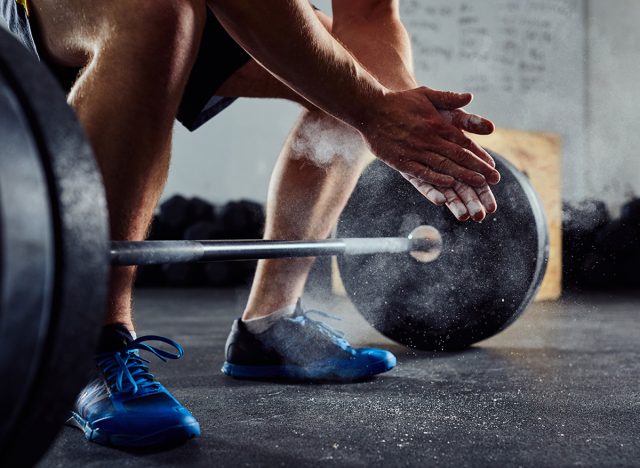Here's How Long You Should Lift Weights To Burn the Most Fat

Many people believe cardio is the only way to burn fat, but that's a common myth. While steady-state cardio can help create a calorie deficit, it doesn't offer the same long-term fat-burning benefits as strength training. In fact, lifting weights not only burns calories during your workout but also stimulates muscle growth, which increases your resting metabolic rate (RMR)—the number of calories your body burns at rest. The more muscle you build, the more energy your body requires, making fat loss more efficient.
In this article, we'll bust the myths surrounding weightlifting and fat loss, explain how long you should lift weights to burn the most fat, and provide a preview of the optimal combination of cardio and strength training for maximum results. Plus, we'll emphasize the importance of pairing these workouts with a dialed-in diet to unlock your fat-burning potential truly.
How Strength Training Burns Fat

Lifting weights increases lean muscle mass, which boosts resting metabolic rate. A May 2021 study from Wiley found that exercise resulted in significant weight loss, fat loss, and visceral fat loss, with no differences found between aerobic and high‐intensity interval training as long as energy expenditure was equal. The best part? The study found that resistance training helps prevent the loss of lean muscle mass. But why is this important? The more muscle you have, the more calories your body burns at rest. Strength training also triggers excess post-exercise oxygen consumption (EPOC). This afterburn effect keeps metabolism elevated for hours after a workout.
Strength training burns fat through several key mechanisms:
- Increased Muscle Mass: Muscle tissue requires more energy than fat tissue, leading to a higher resting metabolic rate.
- EPOC Effect: After a strength training session, your body burns calories to restore oxygen levels and repair muscles.
- Hormonal Benefits: Resistance training promotes the release of growth hormone and testosterone, which support fat metabolism.
- Improved Insulin Sensitivity: Lifting weights helps regulate blood sugar levels, reducing fat storage.
- Greater Total Calorie Burn: Strength training, especially high-intensity lifting, burns many calories during and after workouts.
Compared to steady-state cardio, weightlifting provides a longer-lasting calorie burn. High-intensity resistance training creates a potent fat-burning response.
Optimal Weightlifting Duration for Fat Loss

The ideal weightlifting session lasts 30 to 60 minutes. This timeframe allows for high-intensity training without excessive fatigue. Sessions beyond 60 minutes can lead to diminishing returns. Prolonged workouts increase cortisol, a stress hormone linked to fat retention.
Effective weightlifting for fat loss includes:
- Full-body workouts (3-4 times per week)
- Compound movements (squats, deadlifts, presses, rows)
- Minimal rest (30-60 seconds between sets).
High-Intensity vs. Moderate-Intensity Lifting

High-intensity resistance training (HIRT) burns more fat in less time. It combines heavy lifting with short rest periods. This method keeps the heart rate elevated, increasing calorie burn.
Moderate-intensity strength training focuses on heavier weights and more extended rest. While effective for building muscle, it does not maximize fat loss as efficiently as HIRT.
For fat loss, prioritize:
- Supersets and circuits to keep intensity high
- Shorter workouts (30-45 minutes) with minimal rest
- Higher reps (8-15) with moderate to heavy weights.
Training Frequency: How Often Should You Lift?

For optimal fat loss, lift weights 3 to 5 times per week. Full-body workouts three times a week provide an efficient fat-burning effect. Split routines (upper/lower body) work well for those training four or more days.
Consistency matters. Progressive overload—gradually increasing weight or reps—ensures continued fat loss. Avoid excessive rest days, which can slow metabolism.
Best Strategies for Fat Loss and Common Mistakes to Avoid

To maximize fat loss, follow these key strategies:
- Prioritize Compound Exercises: Multi-joint movements like squats, deadlifts, and presses engage multiple muscle groups and burn more calories.
- Reduce Rest Time: Keeping rest periods between 30-60 seconds maintains an elevated heart rate and increases calorie burn.
- Incorporate Metabolic Resistance Training (MRT): This combines strength and endurance training to create a high-calorie expenditure.
- Use Progressive Overload: Increasing weight, reps, or intensity ensures ongoing muscle growth and fat loss.
- Balance Strength Training with Proper Nutrition: Eating enough protein and staying in a slight calorie deficit optimizes fat loss while preserving muscle.
Many lifters make common mistakes that slow their progress. Avoid these errors:
- Lifting Too Light: Using weights that are too light and performing too many reps without challenge limits fat-burning potential.
- Taking Long Rest Periods: Extended breaks between sets reduce workout intensity and calorie burn.
- Ignoring Progressive Overload: Sticking to the exact weights and reps leads to plateaus in fat loss.
- Neglecting Recovery: Overtraining without proper rest can elevate cortisol and hinder fat loss.
- Skipping Resistance Training in Favor of Cardio: While cardio burns calories, strength training builds the muscle needed for a higher metabolism.
References:
- Bellicha, Alice et al. "Effect of exercise training on weight loss, body composition changes, and weight maintenance in adults with overweight or obesity: An overview of 12 systematic reviews and 149 studies." Obesity reviews : an official journal of the International Association for the Study of Obesity vol. 22 Suppl 4,Suppl 4 (2021): e13256. doi:10.1111/obr.13256
- Greer, Beau Kjerulf et al. "EPOC Comparison Between Resistance Training and High-Intensity Interval Training in Aerobically Fit Women." International journal of exercise science vol. 14,2 1027-1035. 1 Aug. 2021, doi:10.70252/ODIN6912









